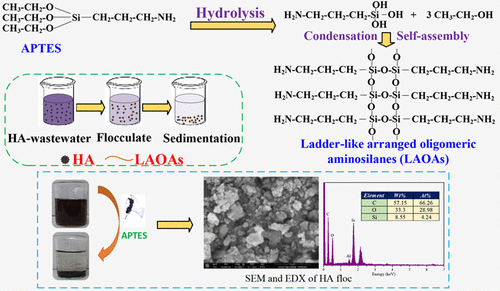当前位置:
X-MOL 学术
›
ACS Sustain. Chem. Eng.
›
论文详情
Our official English website, www.x-mol.net, welcomes your
feedback! (Note: you will need to create a separate account there.)
Efficient Separation of Water-Soluble Humic Acid Using (3-Aminopropyl)triethoxysilane (APTES) for Carbon Resource Recovery from Wastewater
ACS Sustainable Chemistry & Engineering ( IF 7.1 ) Pub Date : 2018-03-19 00:00:00 , DOI: 10.1021/acssuschemeng.7b04507 Tao Zhou 1 , Sheng Huang 2 , Dongjie Niu 1 , Lianghu Su 3 , Guangyin Zhen 4 , Youcai Zhao 1
ACS Sustainable Chemistry & Engineering ( IF 7.1 ) Pub Date : 2018-03-19 00:00:00 , DOI: 10.1021/acssuschemeng.7b04507 Tao Zhou 1 , Sheng Huang 2 , Dongjie Niu 1 , Lianghu Su 3 , Guangyin Zhen 4 , Youcai Zhao 1
Affiliation

|
Humic substances are produced during the microbial degradation of biomolecules and should be recycled because they are an abundant source of carbon, hydrogen, oxygen, and nitrogen. Herein, (3-aminopropyl)triethoxysilane (APTES) was first used to recover carbon-rich water-soluble humic acid (HA) from wastewater, and the operational parameters (i.e., pH, solution temperature, APTES dosage, reaction time, and initial HA concentration) were optimized for separation efficiency. The results showed that the optimal HA separation efficiency (96.7%) could be achieved at an initial HA concentration of 250 mg/L, APTES dosage 4 mL/L, equilibration time 10 min, pH 3.0, and temperature 35 °C. Furthermore, cations (Mg2+ and Ca2+) led to a remarkable separation of HA, while anions (CO32– and SO42–) weakened the aggregation and deposition of HA. Mechanism analysis unveiled that ladderlike oligomeric aminosilanes (LAOAs) were generated by the hydrolysis, condensation, and self-assembly of APTES. The LAOAs were involved in adsorption bridging action with HA, thus efficiently promoting the precipitation of humic substances. The described carbon separation technique (converting dissolved matter into insoluble substances) can be a promising option for the efficient recovery and reutilization of carbon resources in high-concentration organic wastewater.
中文翻译:

使用(3-氨基丙基)三乙氧基硅烷(APTES)高效分离水溶性腐殖酸以回收废水中的碳资源
腐殖质是在生物分子的微生物降解过程中产生的,应该回收利用,因为它们是碳,氢,氧和氮的丰富来源。本文中,首先使用(3-氨基丙基)三乙氧基硅烷(APTES)从废水中回收富碳的水溶性腐殖酸(HA),以及操作参数(例如pH,溶液温度,APTES用量,反应时间和初始浓度)。优化HA浓度以提高分离效率。结果表明,在初始HA浓度为250 mg / L,APTES剂量为4 mL / L,平衡时间为10分钟,pH为3.0,温度为35°C的情况下,可以实现最佳的HA分离效率(96.7%)。此外,阳离子(Mg 2+和Ca 2+)导致HA显着分离,而阴离子(CO 32 –和SO 4 2–)削弱了HA的聚集和沉积。机理分析表明,APTES的水解,缩合和自组装产生了梯状的低聚氨基硅烷(LAOAs)。LAOAs参与了与HA的吸附桥联作用,从而有效地促进了腐殖质的沉淀。所描述的碳分离技术(将溶解物转化为不溶物)对于高浓度有机废水中碳资源的有效回收和再利用可能是一个有前途的选择。
更新日期:2018-03-19
中文翻译:

使用(3-氨基丙基)三乙氧基硅烷(APTES)高效分离水溶性腐殖酸以回收废水中的碳资源
腐殖质是在生物分子的微生物降解过程中产生的,应该回收利用,因为它们是碳,氢,氧和氮的丰富来源。本文中,首先使用(3-氨基丙基)三乙氧基硅烷(APTES)从废水中回收富碳的水溶性腐殖酸(HA),以及操作参数(例如pH,溶液温度,APTES用量,反应时间和初始浓度)。优化HA浓度以提高分离效率。结果表明,在初始HA浓度为250 mg / L,APTES剂量为4 mL / L,平衡时间为10分钟,pH为3.0,温度为35°C的情况下,可以实现最佳的HA分离效率(96.7%)。此外,阳离子(Mg 2+和Ca 2+)导致HA显着分离,而阴离子(CO 32 –和SO 4 2–)削弱了HA的聚集和沉积。机理分析表明,APTES的水解,缩合和自组装产生了梯状的低聚氨基硅烷(LAOAs)。LAOAs参与了与HA的吸附桥联作用,从而有效地促进了腐殖质的沉淀。所描述的碳分离技术(将溶解物转化为不溶物)对于高浓度有机废水中碳资源的有效回收和再利用可能是一个有前途的选择。











































 京公网安备 11010802027423号
京公网安备 11010802027423号